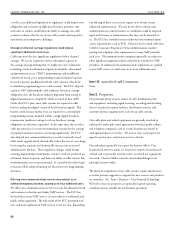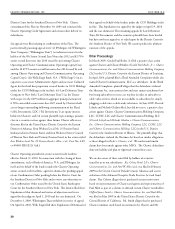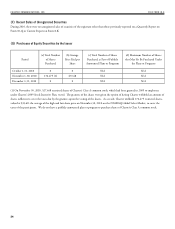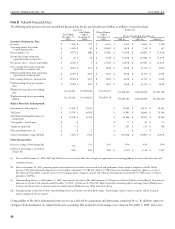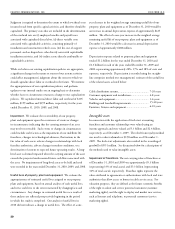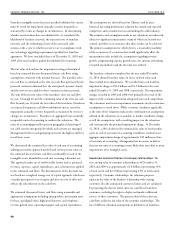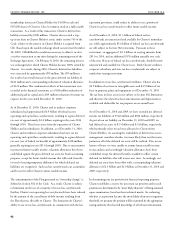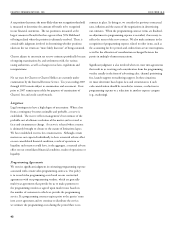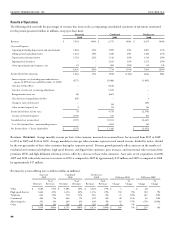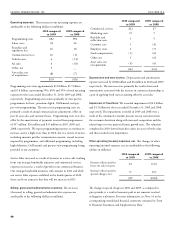Charter 2010 Annual Report Download - page 51
Download and view the complete annual report
Please find page 51 of the 2010 Charter annual report below. You can navigate through the pages in the report by either clicking on the pages listed below, or by using the keyword search tool below to find specific information within the annual report.
Litigation
Programming agreements
In addition, there are other items within our financial statements that
require estimates or judgment that are not deemed critical, such as
the allowance for doubtful accounts and valuations of our derivative
instruments, if any, but changes in estimates or judgment in these
other items could also have a material impact on our financial
statements.
Property, plant and equipment
e cable industry is capital intensive, and a large portion of our
resources are spent on capital activities associated with extending,
rebuilding, and upgrading our cable network. As of December 31,
2010 and 2009, the net carrying amount of our property, plant
and equipment (consisting primarily of cable network assets) was
approximately $6.8 billion (representing 43% of total assets) and
$6.8 billion (representing 41% of total assets), respectively. Total
capital expenditures for the years ended December 31, 2010, 2009,
and 2008 were approximately $1.2 billion, $1.1 billion, and $1.2
billion, respectively.
Effective December 1, 2009, we applied fresh start accounting
resulting in an approximately $2.0 billion increase to total property,
plant and equipment. e cost approach was the primary method
used to establish fair value for our property, plant and equipment
in connection with the application of fresh start accounting. e
cost approach considers the amount required to replace an asset
by constructing or purchasing a new asset with similar utility, then
adjusts the value in consideration of all forms of depreciation as of
the appraisal date.
Capitalization of labor and overhead costs. Costs associated
with network construction, initial customer installations (including
initial installations of new or additional advanced video services),
installation refurbishments, and the addition of network equipment
necessary to provide new or advanced video services, are capitalized.
While our capitalization is based on specific activities, once
capitalized, we track these costs by fixed asset category at the cable
system level, and not on a specific asset basis. For assets that are sold
or retired, we remove the estimated applicable cost and accumulated
depreciation. Costs capitalized as part of initial customer
installations include materials, direct labor, and certain indirect costs.
ese indirect costs are associated with the activities of personnel
who assist in connecting and activating the new service, and consist
•
•of compensation and overhead costs associated with these support
functions. e costs of disconnecting service at a customer’s dwelling
or reconnecting service to a previously installed dwelling are charged
to operating expense in the period incurred. As our service offerings
mature and our reconnect activity increases, our capitalizable
installations will continue to decrease and therefore our operating
expenses will increase. Costs for repairs and maintenance are charged
to operating expense as incurred, while equipment replacement,
including replacement of certain components, and betterments,
including replacement of cable drops from the pole to the dwelling,
are capitalized.
We make judgments regarding the installation and construction
activities to be capitalized. We capitalize direct labor and overhead
using standards developed from actual costs and applicable operational
data. We calculate standards annually (or more frequently if
circumstances dictate) for items such as the labor rates, overhead rates,
and the actual amount of time required to perform a capitalizable activity.
For example, the standard amounts of time required to perform
capitalizable activities are based on studies of the time required to
perform such activities. Overhead rates are established based on an
analysis of the nature of costs incurred in support of capitalizable
activities, and a determination of the portion of costs that is directly
attributable to capitalizable activities. e impact of changes that
resulted from these studies were not material in the periods presented.
Labor costs directly associated with capital projects are capitalized.
Capitalizable activities performed in connection with customer
installations include such activities as:
Dispatching a “truck roll” to the customer’s dwelling for service
connection;
Verification of serviceability to the customer’s dwelling (i.e.,
determining whether the customer’s dwelling is capable of
receiving service by our cable network and/or receiving advanced
or Internet services);
Customer premise activities performed by in-house field
technicians and third-party contractors in connection with
customer installations, installation of network equipment in
connection with the installation of expanded services, and
equipment replacement and betterment; and
V erifying the integrity of the customer’s network connection
by initiating test signals downstream from the headend to the
customer’s digital set-top box.
•
•
•
•


